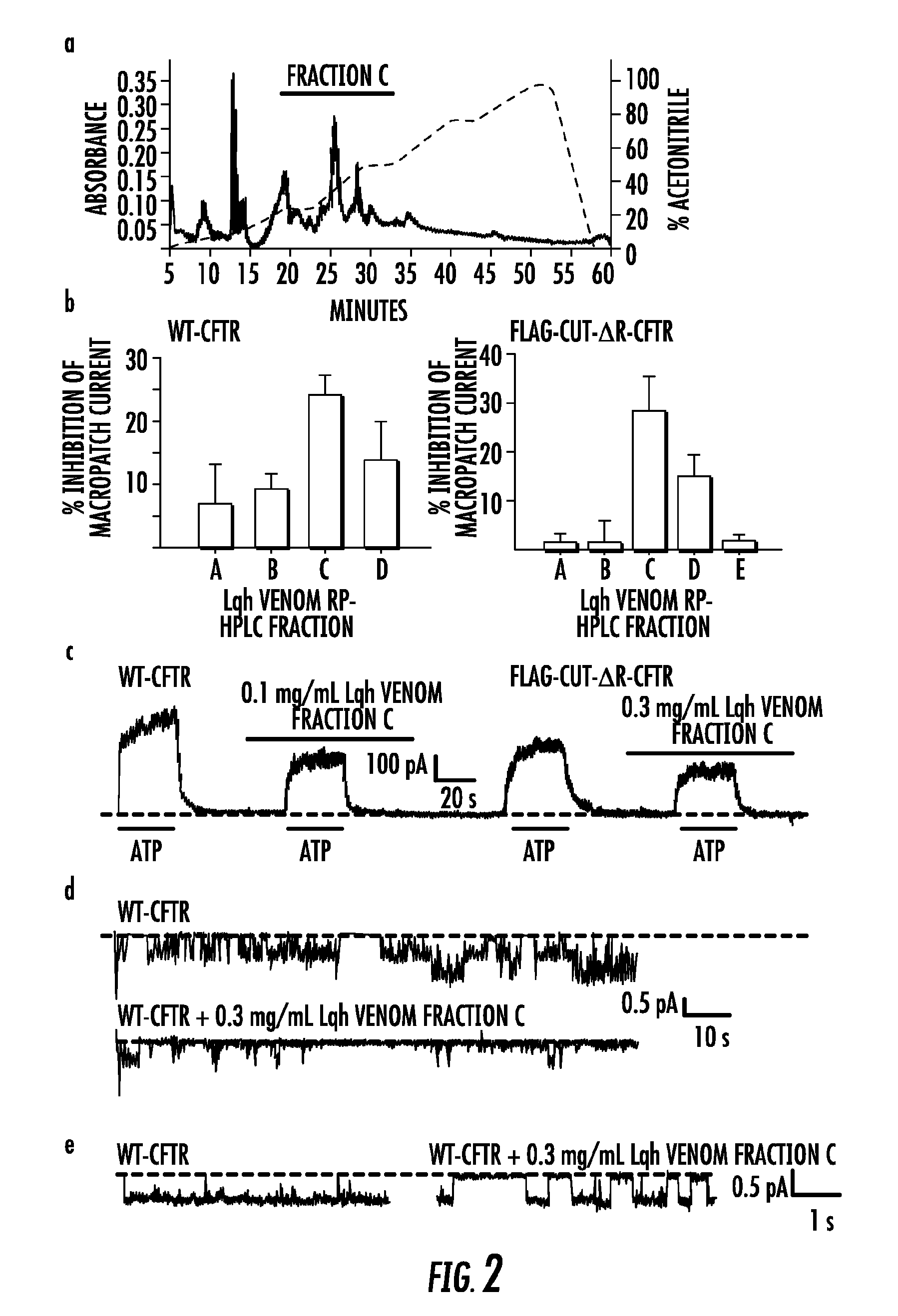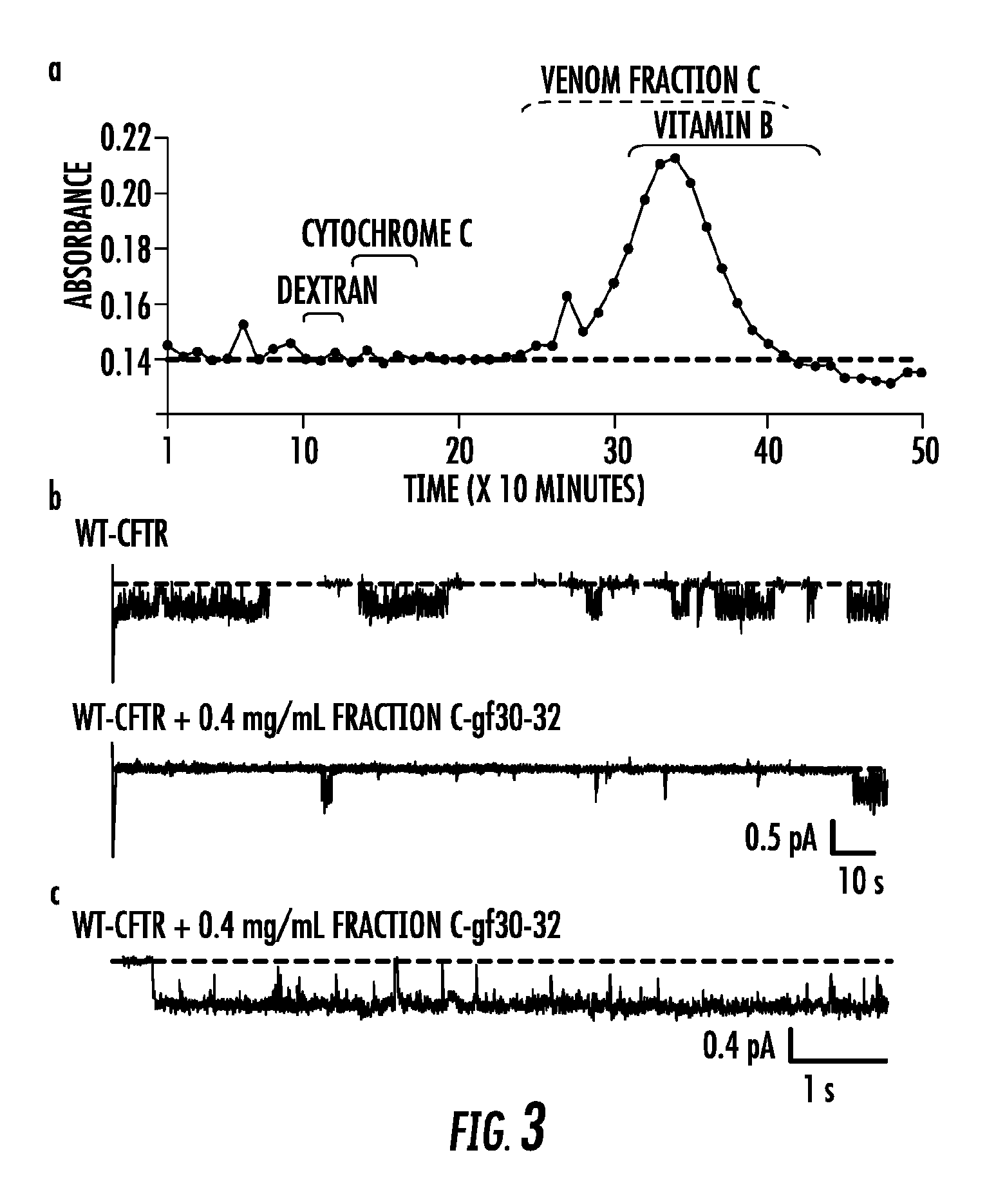Abc transporter ligand
a technology of transporter and ligand, which is applied in the field of ligands for abc transporters, can solve the problems of low affinity and poor specificity of the sup> channel blocker available at present, and the peptide inhibitors of chloride channels of an identified molecular target, including cftr, have not been described, and little is known about. to achieve the effect of reducing chloride transport and abc transporter activity
- Summary
- Abstract
- Description
- Claims
- Application Information
AI Technical Summary
Benefits of technology
Problems solved by technology
Method used
Image
Examples
example 1
Inhibition of CFTR by Scorpion Venom
[0262]Venom from the scorpion L. quinquestriatus hebraeus was obtained from Latoxan (France) and processed as previously-described. Briefly, venom was resuspended in recording solution, disrupted by a tissue grinder, and centrifuged in order to separate the mucous component. The supernatant was then passed through a 10 kDa MW cut-off spin filter to remove high molecular weight components, resulting in “Lqh-pf venom”. Venom or traction concentrations are stated as equivalent to venom dry weight before processing. For toxin separation by chromatography, Lqh-pf venom was resuspended at a concentration of 5 mg / mL equivalent.
[0263]A summary of the inhibitory activity of partially-fractionated venom (“Lqh-pf venom”) on CFTR channels in both macropatches and single-channel patches pulled from Xenopus oocytes is shown in FIG. 1b-d. Lqh-pf venom contains all components a right, FIG. 1b right), which lack the regulatory R domain and therefore do not require...
example 2
Separation of Active Components in Venom
[0264]Lqh-pf venom was fractionated by means of reversed-phase HPLC (RP-HPLC) (FIG. 2a). Components of Lqh-pf venom were separated based on hydrophobicity, using a Waters 1525 binary HPLC coupled to a Waters 2487 dual wavelength absorbance detector, with a Zorbax 300SB-C3 silica column (4.6×250 mm, 5 μm, 300 Å pore size), and a gradient of water and acetonitrile. Size exclusion-chromatography used a 1.4 cm×80 cm chromatography column (BioRad). packed with Sephadex G50 Superfine (Sigma); toxins were eluted using a buffer containing 50 mM Tris-HCl and 100 mM KCl (pH 7.5). Dextran, cytochrome C, and vitamin B were used as standards during column equilibration. All fractions collected via RP-HPLC or size exclusion chromatography were dried under vacuum, then resuspended in the appropriate recording solution, and stored at 80° C. until use. For all chromatograms, the solid line indicates absorbance at 220 ml, The dashed line in RP-HPLC chromatogram...
example 3
Characterization of the Isolated Peptide Ligand
[0269]Initial characterization of the active peptide contained in peak #6 was accomplished by subjecting a small aliquot of the material to MALDI-TOF analysis. A single peptide was identified with a molecular mass of 3,674.6 Da (FIG. 5a), Additional, less / abundant peaks with similar mass were also identified that likely represent different oxidative states of the same toxin; a doubly charged species also was observed (m / z=1,838.8 Da). The peptide in peak #6 then was subjected to automated amino terminal sequencing following destruction of all putative disulfide bridges by reduction, with DTT and alkylation of free cysteines by iodoacetamide. The reduction and alkylation of the native toxin resulted in an increase in molecular mass to 4,138.5 Da as determined by MALDI-TOF, which is in agreement with the modification of eight cysteines; expected mass=4,138.6 Da (Table 2).
TABLE 2Mass spectrometric analysis of native and synthetic GaTx1Modi...
PUM
| Property | Measurement | Unit |
|---|---|---|
| molecular mass | aaaaa | aaaaa |
| molecular weight | aaaaa | aaaaa |
| mass | aaaaa | aaaaa |
Abstract
Description
Claims
Application Information
 Login to View More
Login to View More - R&D
- Intellectual Property
- Life Sciences
- Materials
- Tech Scout
- Unparalleled Data Quality
- Higher Quality Content
- 60% Fewer Hallucinations
Browse by: Latest US Patents, China's latest patents, Technical Efficacy Thesaurus, Application Domain, Technology Topic, Popular Technical Reports.
© 2025 PatSnap. All rights reserved.Legal|Privacy policy|Modern Slavery Act Transparency Statement|Sitemap|About US| Contact US: help@patsnap.com



